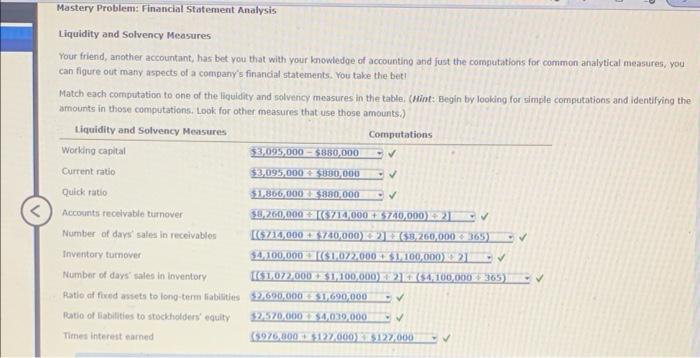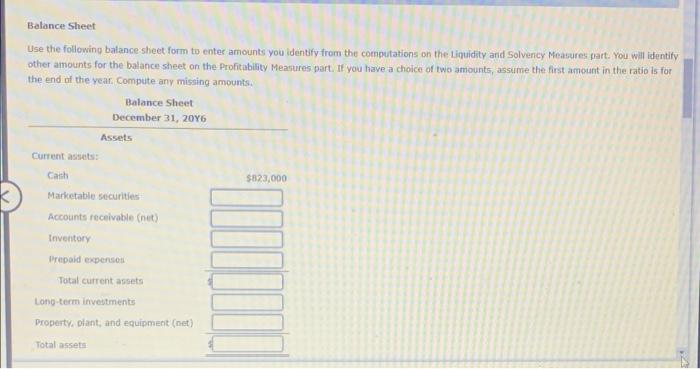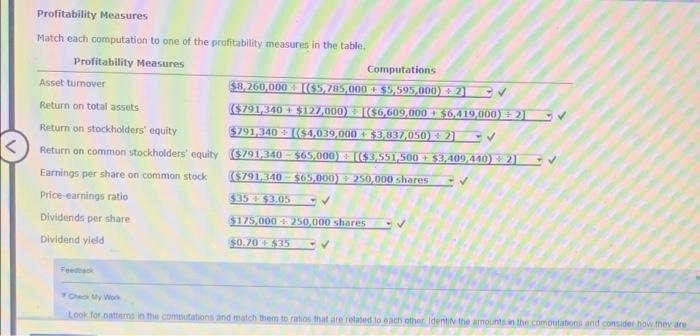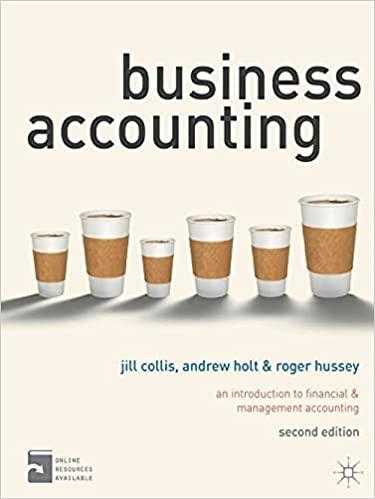Mastery Problem: Financial Statement Analysis Liquidity and Solvency Measures Your friend, another accountant, has bet you that with your knowledge of accounting and just the computations for common analytical measures, you can figure out many aspects of a company's financial statements. You take the bett Match each computation to one of the liquidity and solvency measures in the table. (Hint: Begin by looking for simple computations and identifying the amounts in those computations. Look for other measures that use those amounts.) Liquidity and Solvency Measures Computations Working capital 53,095,000 - $880,000 Current ratio $3,095,000 $80,000 Quick ratio $1,866,000 $300,000 Accounts receivable turnover $8,260,000 (6714,000 + 5740,000) Number of days sales in receivables 163714,000+ $40,000) 2]EX(38,260,000 365 Inventory turnover $4,100,000 ISL.072.000 = 1.100.000) Number of days' sales in inventory 61,072.000+ $1,100,000) 154,100,000 $365) Ratio of fixed assets to long-term liabilities 2,680,0003331,690,000 Ratio of liabilities to stockholders' equity $2.520.000X54,000,000 Times interest eamed (97000051222000 222.000 Balance Sheet Use the following balance sheet form to enter amounts you identify from the computations on the Liquidity and Solvency Measures part. You will identify other amounts for the balance sheet on the Profitability Measures part. If you have a choice of two amounts, assume the first amount in the ratio is for the end of the year. Compute any missing amounts Balance Sheet December 31, 2016 Assets Current assets: Cash $823.000 Marketable Securities Accounts receivable (net) Inventory Prepaid expensou Total current assets Long-term investments Property, plant, and equipment (net) Total asset Inventory Prepaid expenses Total current assets Long-term investments Property, plant, and equipment (net) Total assets Liabilities Current liabilities Long term liabilities Total liabilities Stockholders' Equity Preferred stock, 510 par Common stock, 35 par Retained earnings Total stockholders' equity III. Total liabilities and stockholders' equity Profitability Measures Match each computation to one of the profitability measures in the table Profitability Measures Computations Asset tumover $8,260,000 15,785,000 + $5,595,000) 21 Return on total assets (791,340 + $127,000)|(56,609,000+ 36,419,000) + 2) Return on stockholders' equity $791,340 $4,039,000 $3,8370502 Return on common stockholders' equity $791,340 - $65,000) $63,551,500 + $3,409,440) 21 Earnings per share on common stock (5791340 $65,000) = 250,000 Shares Price earnings ratio $1538$3.05










